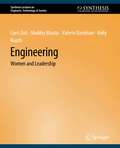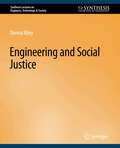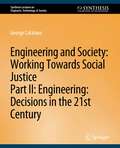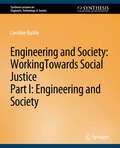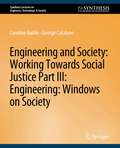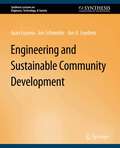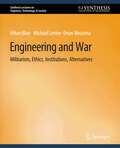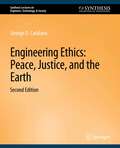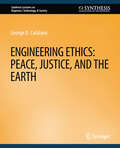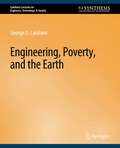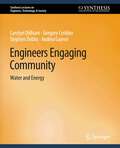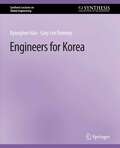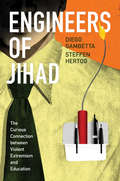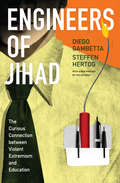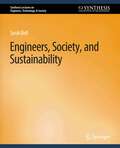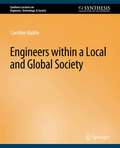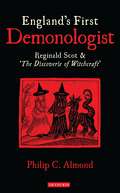- Table View
- List View
Engendering the Buddhist State: Territory, Sovereignty and Sexual Difference in the Inventions of Angkor (Routledge Critical Studies in Buddhism)
by Ashley ThompsonDrawing from more than a decade of field and archival research, this monograph concerns Cambodian cultural history and historiography, with an ultimate aim of broadening and deepening bases for understanding the Cambodian Theravadin politico-cultural complex. The book takes the form of an interdisciplinary analysis of performative and representational strategies for constituting social collectivities, largely developed at Angkor. The analysis involves extended close readings of a wide range of cultural artefacts including epigraphic and manuscript texts, sculpture and ritual practices. The author proposes a critical re-evaluation of dominant paradigms of Cambodian historiography in view of engendering new histories, or hybrid histories, which make room for previously absent perspectives and voices, while developing new theoretical tools engaging with and partially derived from "indigenous" narrative practices in the broadest sense. In this history-making process the historical event is shown to never be entirely separable from its aesthetic representation. Particular attention is paid to the roles of sexual difference in such (re)constructions of history. The book presents a theory of power capable of accounting for the historical phenomena by which vernacular cultures appropriate, subvert and submit to cosmopolitan forces. It charts out a novel approach to the study of classical Southeast Asian materials, and is of interest to students and scholars of Asian Art, Religion and Philosophy, Buddhism and Southeast Asian History.
Engineering: Women and Leadership (Synthesis Lectures on Engineers, Technology, & Society)
by Corri Zoli Shobha Bhatia Valerie Davidson Kelly RuschIn this book we explore a sea change occurring in leadership for academic women in the sciences and engineering. Our approach is a two-pronged one: On the one hand, we outline the nature of the changes and their sources, both in various literatures and from program research results. On the other hand, we specify and provide detail about the persistent problems and obstacles that remain as barriers to women’s full participation in academic science and engineering, their career advancement and success, and, most important, their role as leaders in making change. At the heart of this book is our goal to give some shape to the research, practice, and programs developed by women academic leaders making institutional change in the sciences and engineering. Table of Contents: Women in a New Era of Academic Leadership / Background: Academic Leadership for Women in Science and Engineering / Gender and Leadership: Theories and Applications / Women in Engineering Leadership Institute: Critical Issues for Women Academic Engineers as Leaders / From Success Stories to Success Strategies: Leadership for Promoting Diversity in Academic Science and Engineering / Conclusion
Engineering and Social Justice (Synthesis Lectures on Engineers, Technology, & Society)
by Donna RileyThe profession of engineering in the United States has historically served the status quo, feeding an ever-expanding materialistic and militaristic culture, remaining relatively unresponsive to public concerns, and without significant pressure for change from within. This book calls upon engineers to cultivate a passion for social justice and peace and to develop the skill and knowledge set needed to take practical action for change within the profession. Because many engineers do not receive education and training that support the kinds of critical thinking, reflective decision-making, and effective action necessary to achieve social change, engineers concerned with social justice can feel powerless and isolated as they remain complicit. Utilizing techniques from radical pedagogies of liberation and other movements for social justice, this book presents a roadmap for engineers to become empowered and engage one another in a process of learning and action for social justice and peace. Table of contents: What Do we Mean by Social Justice? / Mindsets in Engineering / Engineering and Social Injustice / Toward a More Socially Just Engineering / Turning Knowledge into Action: Strategies for Change / Parting Lessons for the Continuing Struggle
Engineering and Society: Decisions in the 21st Century (Synthesis Lectures on Engineers, Technology, & Society)
by Caroline Baillie George CatalanoPart II: Engineering Decisions in the 21st Century Engineers work in an increasingly complex entanglement of ideas, people, cultures, technology, systems and environments. Today, decisions made by engineers often have serious implications for not only their clients but for society as a whole and the natural world. Such decisions may potentially influence cultures, ways of living, as well as alter ecosystems which are in delicate balance. In order to make appropriate decisions and to co-create ideas and innovations within and among the complex networks of communities which currently exist and are shaped by our decisions, we need to regain our place as professionals, to realise the significance of our work and to take responsibility in a much deeper sense. Engineers must develop the 'ability to respond' to emerging needs of all people, across all cultures. To do this requires insights and knowledge which are at present largely within the domain of the social and political sciences but which need to be shared with our students in ways which are meaningful and relevant to engineering. This book attempts to do just that. In Part 1 Baillie introduces ideas associated with the ways in which engineers relate to the communities in which they work. Drawing on scholarship from science and technology studies, globalisation and development studies, as well as work in science communication and dialogue, this introductory text sets the scene for an engineering community which engages with the public. In Part 2 Catalano frames the thinking processes necessary to create ethical and just decisions in engineering, to understand the implications of our current decision making processes and think about ways in which we might adapt these to become more socially just in the future. In Part 3 Baillie and Catalano have provided case studies of everyday issues such as water, garbage and alarm clocks, to help us consider how we might see through the lenses of our new knowledge from Parts 1 and 2 and apply this to our everyday existence as engineers. Table of Contents: Making Decisions in the 21st Century / Ethics / Landmines and the War in Iraq / Hurricane Katrina and the Flooding of New Orleans / Disappearing Bumble Bees / Engineering and Traditional Approaches / Engineering and Freedom / Engineering and Chaos / Engineering and a Morally Deep World / Engineering and Globalism / Engineering and Love / Case Study Application / Final Thoughts
Engineering and Society: Engineering and Society (Synthesis Lectures on Engineers, Technology, & Society)
by Caroline Baillie George CatalanoEngineers work in an increasingly complex entanglement of ideas, people, cultures, technology, systems and environments. Today, decisions made by engineers often have serious implications for not only their clients but for society as a whole and the natural world. Such decisions may potentially influence cultures, ways of living, as well as alter ecosystems which are in delicate balance. In order to make appropriate decisions and to co-create ideas and innovations within and among the complex networks of communities which currently exist and are shaped by our decisions, we need to regain our place as professionals, to realise the significance of our work and to take responsibility in a much deeper sense. Engineers must develop the 'ability to respond' to emerging needs of all people, across all cultures. To do this requires insights and knowledge which are at present largely within the domain of the social and political sciences but which need to be shared with our students in ways which are meaningful and relevant to engineering. This book attempts to do just that. In Part 1 Baillie introduces ideas associated with the ways in which engineers relate to the communities in which they work. Drawing on scholarship from science and technology studies, globalisation and development studies, as well as work in science communication and dialogue, this introductory text sets the scene for an engineering community which engages with the public. In Part 2 Catalano frames the thinking processes necessary to create ethical and just decisions in engineering, to understand the implications of our current decision making processes and think about ways in which we might adapt these to become more socially just in the future. In Part 3 Baillie and Catalano have provided case studies of everyday issues such as water, garbage and alarm clocks, to help us consider how we might see through the lenses of our new knowledge from Parts 1 and 2 and apply this to our every day existence as engineers. Table of Contents: Introduction / Engineering and Society / Engineering and the Public / Globalisation, Development, and Technology
Engineering and Society: Windows on Society (Synthesis Lectures on Engineers, Technology, & Society)
by Caroline Baillie George CatalanoEngineers work in an increasingly complex entanglement of ideas, people, cultures, technology, systems and environments. Today, decisions made by engineers often have serious implications for not only their clients but for society as a whole and the natural world. Such decisions may potentially influence cultures, ways of living, as well as alter ecosystems which are in delicate balance. In order to make appropriate decisions and to co-create ideas and innovations within and among the complex networks of communities which currently exist and are shaped by our decisions, we need to regain our place as professionals, to realise the significance of our work and to take responsibility in a much deeper sense. Engineers must develop the 'ability to respond' to emerging needs of all people, across all cultures. To do this requires insights and knowledge which are at present largely within the domain of the social and political sciences but which need to be shared with our students in ways which are meaningful and relevant to engineering. This book attempts to do just that. In Part 1 Baillie introduces ideas associated with the ways in which engineers relate to the communities in which they work. Drawing on scholarship from science and technology studies, globalisation and development studies, as well as work in science communication and dialogue, this introductory text sets the scene for an engineering community which engages with the public. In Part 2 Catalano frames the thinking processes necessary to create ethical and just decisions in engineering, to understand the implications of our current decision making processes and think about ways in which we might adapt these to become more socially just in the future. In Part 3 Baillie and Catalano have provided case studies of everyday issues such as water, garbage and alarm clocks, to help us consider how we might see through the lenses of our new knowledge from Parts 1 and 2 and apply this to our everyday existence as engineers. Table of Contents: Introduction / Throwing Away Rubbish / Turning on the Tap / Awakened by an Alarm Clock / Driving the SUV / Travelling to Waikiki Beach
Engineering and Sustainable Community Development (Synthesis Lectures on Engineers, Technology, & Society)
by Juan Lucena Jen Schneider Jon A. LeydensThis book, Engineering and Sustainable Community Development, presents an overview of engineering as it relates to humanitarian engineering, service learning engineering, or engineering for community development, often called sustainable community development (SCD). The topics covered include a history of engineers and development, the problems of using industry-based practices when designing for communities, how engineers can prepare to work with communities, and listening in community development. It also includes two case studies -- one of engineers developing a windmill for a community in India, and a second of an engineer "mapping communities" in Honduras to empower people to use water effectively -- and student perspectives and experiences on one curricular model dealing with community development. Table of Contents: Introduction / Engineers and Development: From Empires to Sustainable Development / Why Design for Industry Will Not Work as Design for Community / Engineering with Community / Listening to Community / ESCD Case Study 1: Sika Dhari's Windmill / ESCD Case Study 2: Building Organizations and Mapping Communities in Honduras / Students' Perspectives on ESCD: A Course Model / Beyond Engineers and Community: A Path Forward
Engineering and War: Militarism, Ethics, Institutions, Alternatives (Synthesis Lectures on Engineers, Technology, & Society)
by Ethan Blue Michael Levine Dean NieusmaThis book investigates the close connections between engineering and war, broadly understood, and the conceptual and structural barriers that face those who would seek to loosen those connections. It shows how military institutions and interests have long influenced engineering education, research, and practice and how they continue to shape the field in the present. The book also provides a generalized framework for responding to these influences useful to students and scholars of engineering, as well as reflective practitioners. The analysis draws on philosophy, history, critical theory, and technology studies to understand the connections between engineering and war and how they shape our very understandings of what engineering is and what it might be. After providing a review of diverse dimensions of engineering itself, the analysis shifts to different dimensions of the connections between engineering and war. First, it considers the ethics of war generally and then explores questions of integrity for engineering practitioners facing career decisions relating to war. Next, it considers the historical rise of the military-industrial-academic complex, especially from World War II to the present. Finally, it considers a range of responses to the militarization of engineering from those who seek to unsettle the status quo. Only by confronting the ethical, historical, and political consequences of engineering for warfare, this book argues, can engineering be sensibly reimagined.
Engineering Ethics: Peace, Justice, and the Earth, Second Edition (Synthesis Lectures on Engineers, Technology, & Society)
by George D. CatalanoA response of the engineering profession to the challenges of security, poverty and underdevelopment, environmental sustainability, and native cultures is described. Ethical codes, which govern the behavior of engineers, are examined from a historical perspective linking the prevailing codes to models of the natural world. A new ethical code based on a recently introduced model of Nature as an integral community is provided and discussed. Applications of the new code are described using a case study approach. With the ethical code based on an integral community in place, new design algorithms are developed and also explored using case studies. Implications of the proposed changes in ethics and design on engineering education are considered. Table of Contents: Preface / Acknowledgments / Introduction / Engineering Ethics / Models of the Earth / Engineering in a Morally Deep World / Engineering Design in a Morally Deep World / Implications for Engineering Education / Final Thoughts / References / Author's Biography
Engineering Ethics: Peace, Justice, and the Earth (Synthesis Lectures on Engineers, Technology, & Society)
by George D. CatalanoA response of the engineering profession to the challenges of security, poverty and under-development, and environmental sustainability is described. Ethical codes, which govern the behavior of engineers, are examined from a historical perspective linking the prevailing codes to models of the natural world.Anewethical code based on a recently introduced model of Nature as an integral community is provided and discussed. Applications of the new code are described using a case study approach. With the ethical code based on an integral community in place, a new design algorithm is developed and also explored using case studies. Implications of the proposed changes in ethics and design on engineering education are considered.
Engineering, Poverty, and the Earth (Synthesis Lectures on Engineers, Technology, & Society)
by George D. CatalanoIn the present work, the growing awareness in engineering of the profession’s responsibility towards the environment and the poor is considered. The following approach is taken: a brief overview of the issues of poverty particularly in the U.S. and the deterioration of the natural world with a focus on the Arctic is provided. Case studies involving New Orleans in the aftermath of Hurricane Katrina and the status of polar bears in a time of shrinking Arctic ice cover are detailed. Recent developments in engineering related to the issues of poverty and the environment are discussed. A new paradigm for engineering based on the works of Leonardo Boff and Thomas Berry, one that places an important emphasis upon a community, is explored.
Engineers Engaging Community: Water and Energy (Synthesis Lectures on Engineers, Technology, & Society)
by Carolyn Oldham Gregory Crebbin Stephen Dobbs Andrea GaynorWater and energy are fundamental elements of community well-being and economic development, and a key focus of engineering efforts the world over. As such, they offer outstanding opportunities for the development of socially just engineering practices. This work examines the engineering of water and energy systems with a focus on issues of social justice and sustainability. A key theme running through the work is engaging community on water and energy engineering projects: How is this achieved in diverse contexts? And, what can we learn from past failures and successes in water and energy engineering? The book includes a detailed case study of issues involved in the provision of water and energy, among other needs, in a developing and newly independent nation, East Timor.
Engineers for Korea (Synthesis Lectures on Global Engineering)
by Kyonghee Han Gary Lee DowneyThis book follows the fraught attempts of engineers to identify with Korea as a whole. It is for engineers, both Korean and non-Korean, who seek to become better critical analysts of their own expertise, identities, and commitments. It is for non-engineers who encounter or are affected by Korean engineers and engineering, and want to understand and engage them. It is for researchers who serve as critical participants in the making of engineers and puzzle over the contents and effects of techno-national formation.
Engineers of Jihad: The Curious Connection between Violent Extremism and Education
by Diego Gambetta Steffen HertogThe violent actions of a few extremists can alter the course of history, yet there persists a yawning gap between the potential impact of these individuals and what we understand about them. In Engineers of Jihad, Diego Gambetta and Steffen Hertog uncover two unexpected facts, which they imaginatively leverage to narrow that gap: they find that a disproportionate share of Islamist radicals come from an engineering background, and that Islamist and right-wing extremism have more in common than either does with left-wing extremism, in which engineers are absent while social scientists and humanities students are prominent.Searching for an explanation, they tackle four general questions about extremism: Under which socioeconomic conditions do people join extremist groups? Does the profile of extremists reflect how they self-select into extremism or how groups recruit them? Does ideology matter in sorting who joins which group? Lastly, is there a mindset susceptible to certain types of extremism?Using rigorous methods and several new datasets, they explain the link between educational discipline and type of radicalism by looking at two key factors: the social mobility (or lack thereof) for engineers in the Muslim world, and a particular mindset seeking order and hierarchy that is found more frequently among engineers. Engineers' presence in some extremist groups and not others, the authors argue, is a proxy for individual traits that may account for the much larger question of selective recruitment to radical activism.Opening up markedly new perspectives on the motivations of political violence, Engineers of Jihad yields unexpected answers about the nature and emergence of extremism.
Engineers of Jihad: The Curious Connection between Violent Extremism and Education
by Diego Gambetta Steffen HertogThe violent actions of a few extremists can alter the course of history, yet there persists a yawning gap between the potential impact of these individuals and what we understand about them. In Engineers of Jihad, Diego Gambetta and Steffen Hertog uncover two unexpected facts, which they imaginatively leverage to narrow that gap: they find that a disproportionate share of Islamist radicals come from an engineering background, and that Islamist and right-wing extremism have more in common than either does with left-wing extremism, in which engineers are absent while social scientists and humanities students are prominent.Searching for an explanation, they tackle four general questions about extremism: Under which socioeconomic conditions do people join extremist groups? Does the profile of extremists reflect how they self-select into extremism or how groups recruit them? Does ideology matter in sorting who joins which group? Lastly, is there a mindset susceptible to certain types of extremism?Using rigorous methods and several new datasets, they explain the link between educational discipline and type of radicalism by looking at two key factors: the social mobility (or lack thereof) for engineers in the Muslim world, and a particular mindset seeking order and hierarchy that is found more frequently among engineers. Engineers' presence in some extremist groups and not others, the authors argue, is a proxy for individual traits that may account for the much larger question of selective recruitment to radical activism.Opening up markedly new perspectives on the motivations of political violence, Engineers of Jihad yields unexpected answers about the nature and emergence of extremism.
Engineers of Jihad: The Curious Connection between Violent Extremism and Education
by Diego Gambetta Steffen HertogThe violent actions of a few extremists can alter the course of history, yet there persists a yawning gap between the potential impact of these individuals and what we understand about them. In Engineers of Jihad, Diego Gambetta and Steffen Hertog uncover two unexpected facts, which they imaginatively leverage to narrow that gap: they find that a disproportionate share of Islamist radicals come from an engineering background, and that Islamist and right-wing extremism have more in common than either does with left-wing extremism, in which engineers are absent while social scientists and humanities students are prominent.Searching for an explanation, they tackle four general questions about extremism: Under which socioeconomic conditions do people join extremist groups? Does the profile of extremists reflect how they self-select into extremism or how groups recruit them? Does ideology matter in sorting who joins which group? Lastly, is there a mindset susceptible to certain types of extremism?Using rigorous methods and several new datasets, they explain the link between educational discipline and type of radicalism by looking at two key factors: the social mobility (or lack thereof) for engineers in the Muslim world, and a particular mindset seeking order and hierarchy that is found more frequently among engineers. Engineers' presence in some extremist groups and not others, the authors argue, is a proxy for individual traits that may account for the much larger question of selective recruitment to radical activism.Opening up markedly new perspectives on the motivations of political violence, Engineers of Jihad yields unexpected answers about the nature and emergence of extremism.
Engineers of Jihad: The Curious Connection between Violent Extremism and Education
by Diego Gambetta Steffen HertogThe violent actions of a few extremists can alter the course of history, yet there persists a yawning gap between the potential impact of these individuals and what we understand about them. In Engineers of Jihad, Diego Gambetta and Steffen Hertog uncover two unexpected facts, which they imaginatively leverage to narrow that gap: they find that a disproportionate share of Islamist radicals come from an engineering background, and that Islamist and right-wing extremism have more in common than either does with left-wing extremism, in which engineers are absent while social scientists and humanities students are prominent.Searching for an explanation, they tackle four general questions about extremism: Under which socioeconomic conditions do people join extremist groups? Does the profile of extremists reflect how they self-select into extremism or how groups recruit them? Does ideology matter in sorting who joins which group? Lastly, is there a mindset susceptible to certain types of extremism?Using rigorous methods and several new datasets, they explain the link between educational discipline and type of radicalism by looking at two key factors: the social mobility (or lack thereof) for engineers in the Muslim world, and a particular mindset seeking order and hierarchy that is found more frequently among engineers. Engineers' presence in some extremist groups and not others, the authors argue, is a proxy for individual traits that may account for the much larger question of selective recruitment to radical activism.Opening up markedly new perspectives on the motivations of political violence, Engineers of Jihad yields unexpected answers about the nature and emergence of extremism.
Engineers of Jihad: The Curious Connection between Violent Extremism and Education
by Diego Gambetta Steffen HertogThe violent actions of a few extremists can alter the course of history, yet there persists a yawning gap between the potential impact of these individuals and what we understand about them. In Engineers of Jihad, Diego Gambetta and Steffen Hertog uncover two unexpected facts, which they imaginatively leverage to narrow that gap: they find that a disproportionate share of Islamist radicals come from an engineering background, and that Islamist and right-wing extremism have more in common than either does with left-wing extremism, in which engineers are absent while social scientists and humanities students are prominent.Searching for an explanation, they tackle four general questions about extremism: Under which socioeconomic conditions do people join extremist groups? Does the profile of extremists reflect how they self-select into extremism or how groups recruit them? Does ideology matter in sorting who joins which group? Lastly, is there a mindset susceptible to certain types of extremism?Using rigorous methods and several new datasets, they explain the link between educational discipline and type of radicalism by looking at two key factors: the social mobility (or lack thereof) for engineers in the Muslim world, and a particular mindset seeking order and hierarchy that is found more frequently among engineers. Engineers' presence in some extremist groups and not others, the authors argue, is a proxy for individual traits that may account for the much larger question of selective recruitment to radical activism.Opening up markedly new perspectives on the motivations of political violence, Engineers of Jihad yields unexpected answers about the nature and emergence of extremism.
Engineers, Society, and Sustainability (Synthesis Lectures on Engineers, Technology, & Society)
by Sarah BellSustainable development is one of the key challenges of the twenty-first century. The engineering profession is central to achieving sustainable development. To date, engineering contributions to sustainability have focused on reducing the environmental impacts of development and improving the efficiency of resource use. This approach is consistent with dominant policy responses to environmental problems, which have been characterised as ecological modernisation. Ecological modernisation assumes that sustainability can be addressed by reforming modern society and developing environmental technologies. Environmental philosophers have questioned these assumptions and call into question the very nature of modern society as underlying the destruction of nature and the persistence of social inequality. Central to the crises of ecology and human development are patterns of domination and the separation of nature and culture. Engineering has a clear role to play in ecological modernisation, but its role in more radical visions of sustainability is uncertain. Actor-network theory provides an analysis of socio-technical systems which does not require the separation of nature and culture, and it provides a way of thinking about how engineers are involved in shaping society and its relationship to the environment. It describes the world in terms of relationships between human and non-human actors. It shows that social relationships are mediated by technologies and non-human nature, and that assumptions about society and behaviour are ""baked-in"" to technological systems. Modern infrastructure systems are particularly important in shaping society and have significant environmental impacts. Modern infrastructure has allowed the consumption of resources far beyond basic human needs in developed countries. Failure to deliver infrastructure services has resulted in billions of the world's poorest people missing out on the benefits of modern development. Engineers have an important role to play in developing new infrastructure systems which acknowledge the relationships between technology and society in shaping demand for resources and environmental impacts, as well as alleviating poverty. Engineers have an important role in mediating between the values of society, clients, the environment and the possibilities of technology. Constructive Technology Assessment and Value Sensitive Design are two methodologies which engineers are using to better account for the social and ethical implications of their work. Understanding engineering as a hybrid, socio-technical profession can help develop new ways of working that acknowledge the importance of technology and infrastructure in shaping social relationships that are central to achieving sustainability. Table of Contents: The Origins of Sustainability / Ecological Modernisation / Environmental Ethics / Society and Technology / Engineering Consumption / Sustainable Urban Water Systems / Engineering, Technology and Ethics / Conclusion
Engineers within a Local and Global Society (Synthesis Lectures on Engineers, Technology, & Society)
by Caroline BaillieEngineers, Technology and Society presents topics intended to aid the practicing engineer in reflecting upon the nature and purpose of their own practice within the engineering profession and how that is related to and implicated in social, economic and political issues. The series will include external relations between engineering, economic systems and social and political practices, as well as power structures and working conditions within the organisation. In an increasingly competitive and hostile environment in which practicing engineers are forced to spend their lives fighting for higher profit margins, many engineers become despondent and often leave the profession just a few years after graduation. They do not feel they are engineering for those in need in the world but for a small minority who can pay. There are an increasing number of engineers in the workplace who feel dissatisfied with these issues but do not know where to begin to address them. It is hoped that these books will start a conversation in many parts of the world where diverse engineers are working. This introductory book of the series presents an overview of the key issues at stake. I consider how, as engineers, we might decide what is the right thing to do by exploring rights and notions of freedom and what these might mean in a world where we are, according to some, ‘training for compliance’. I consider engineering in the past and how it has been used to contribute to social contexts in the Western world as well as in developing countries. I look at our responsibility as engineers to learn from the past to enhance our understanding and take appropriate action related to contemporary industrial development and globalization. Finally, I present a case study of my own engineering for others to critique. Practicing what you preach is never easy and living as a just engineer presents many challenges. As Ursula Franklin states clearly in her Massey lectures which I discuss in chapter 1, engineers have choices; it is up to us to ensure that we are aware of the way in which our engineering practice contributes to global social, economic and political issues so that we are able to make response – able choices.
England's First Demonologist: Reginald Scot and 'The Discoverie of Witchcraft'
by Philip C. Almond'The fables of witchcraft have taken so fast hold and deepe root in the heart of man, that few or none can indure with patience the hand and correction of God.' Reginald Scot, whose words these are, published his remarkable book The Discoverie of Witchcraft in 1584. England's first major work of demonology, witchcraft and the occult, the book was unashamedly sceptical. It is said that so outraged was King James VI of Scotland by the disbelieving nature of Scot's work that, on James' accession to the English throne in 1603, he ordered every copy to be destroyed. Yet for all the anger directed at Scot, and his scorn for Stuart orthodoxy about wiches, the paradox was that his detailed account of sorcery helped strengthen the hold of European demonologies in England while also inspiring the distinctively English tradition of secular magic and conjuring. Scot's influence was considerable. Shakespeare drew on The Discoverie of Witchcraft for his depiction of the witches in Macbeth. So too did fellow-playwright Thomas Middleton in his tragi-comedy The Witch.Recognising Scot's central importance in the history of ideas, Philip Almond places his subject in the febrile context of his age, examines the chief themes of his work and shows why his writings became a sourcebook for aspiring magicians and conjurors for several hundred years. England's First Demonologist makes a notable contribution to a fascinating but unjustly neglected topic in the study of Early Modern England and European intellectual history.
England's First Demonologist: Reginald Scot and 'The Discoverie of Witchcraft'
by Philip C. AlmondThe fables of witchcraft have taken so fast hold and deepe root in the heart of man, that few or none can indure with patience the hand and correction of God.' Reginald Scot, whose words these are, published his remarkable book The Discoverie of Witchcraft in 1584. England's first major work of demonology, witchcraft and the occult, the book was unashamedly sceptical. It is said that so outraged was King James VI of Scotland by the disbelieving nature of Scot's work that, on James' accession to the English throne in 1603, he ordered every copy to be destroyed. Yet for all the anger directed at Scot, and his scorn for Stuart orthodoxy about wiches, the paradox was that his detailed account of sorcery helped strengthen the hold of European demonologies in England while also inspiring the distinctively English tradition of secular magic and conjuring. Scot's influence was considerable. Shakespeare drew on The Discoverie of Witchcraft for his depiction of the witches in Macbeth. So too did fellow-playwright Thomas Middleton in his tragi-comedy The Witch. Recognising Scot's central importance in the history of ideas, Philip Almond places his subject in the febrile context of his age, examines the chief themes of his work and shows why his writings became a sourcebook for aspiring magicians and conjurors for several hundred years. England's First Demonologist makes a notable contribution to a fascinating but unjustly neglected topic in the study of Early Modern England and European intellectual history.'This is the first full-length study of what to most people is the most famous and influential book about witchcraft to emerge from early modern England; and it significantly advances our knowledge of both text and author.' - Ronald Hutton, Professor of History, University of Bristol
England’s Other Countrymen: Black Tudor Society (Blackness in Britain)
by Onyeka NubiaThe Tudor period remains a source of timeless fascination, with endless novels, TV programmes and films depicting the period in myriad ways. And yet our image of the Tudor era remains overwhelmingly white. This ground-breaking and provocative new book seeks to redress the balance: revealing not only how black presence in Tudor England was far greater than has previously been recognised, but that Tudor conceptions of race were far more complex than we have been led to believe. Onyeka Nubia's original research shows that Tudors from many walks of life regularly interacted with people of African descent, both at home and abroad, revealing a genuine pragmatism towards race and acceptance of difference. Nubia also rejects the influence of the 'Curse of Ham' myth on Tudor thinking, persuasively arguing that many of the ideas associated with modern racism are in fact relatively recent developments.England's Other Countrymen is a bravura and eloquent forgotten history of diversity and cultural exchange, and casts a new light on our own attitudes towards race.
England’s Other Countrymen: Black Tudor Society (Blackness in Britain)
by Onyeka NubiaThe Tudor period remains a source of timeless fascination, with endless novels, TV programmes and films depicting the period in myriad ways. And yet our image of the Tudor era remains overwhelmingly white. This ground-breaking and provocative new book seeks to redress the balance: revealing not only how black presence in Tudor England was far greater than has previously been recognised, but that Tudor conceptions of race were far more complex than we have been led to believe. Onyeka Nubia's original research shows that Tudors from many walks of life regularly interacted with people of African descent, both at home and abroad, revealing a genuine pragmatism towards race and acceptance of difference. Nubia also rejects the influence of the 'Curse of Ham' myth on Tudor thinking, persuasively arguing that many of the ideas associated with modern racism are in fact relatively recent developments.England's Other Countrymen is a bravura and eloquent forgotten history of diversity and cultural exchange, and casts a new light on our own attitudes towards race.
English and Catholic: The Lords Baltimore in the Seventeenth Century (The Johns Hopkins University Studies in Historical and Political Science #122)
by John D. KruglerIn the sixteenth and seventeenth centuries, to be English and Catholic was to face persecution, financial penalties, and sometimes death. Yet some English Catholics prospered, reconciling their faith and loyalty to their country. Among the most prominent was George Calvert, a talented and ambitious man who successfully navigated the politics of court and became secretary of state under King James I. A conforming Protestant from the age of twelve, Calvert converted back to Catholicism when a political crisis forced him to resign his position in 1625. The king rewarded Calvert by naming him Baron of Baltimore in Ireland. Insulated by wealth, with the support of powerful friends, and no longer occupied with court business, Baltimore sought to exploit his land grants in Ireland and Newfoundland. Seeking to increase his own fortune and status while enlarging the king's dominions, he embarked on a series of colonial enterprises that eventually led to Maryland.The experiences of Calvert and his heirs foster our understanding of politics and faith in Jacobean England. They also point to one of the earliest codifications of religious liberty in America, for in founding Maryland, Calvert and his son Cecil envisioned a prosperous society based on freedom of conscience. In English and Catholic, John D. Krugler traces the development of the "Maryland Designe," the novel solution the Calverts devised to resolve the conflict of loyalty they faced as English Catholics. In doing so, Krugler places the founding and early history of Maryland in the context of pervasive anxieties in England over identity, allegiance, and conscience.Explaining the evolution of the Calvert vision, Krugler ties together three main aspects of George Calvert's career: his nationalism and enthusiasm for English imperialism; his aim to find fortune and fame; and his deepening sense of himself as a Catholic. Skillfully told here, the story of the Calverts' bold experiment in advancing freedom of conscience is also the story of the roots of American liberty.

